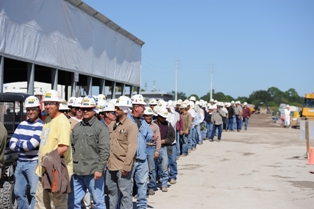
The large bang in August 2010 that signaled the demolition of FPL’s 1960s-era Cape Canaveral Power Plant in Cocoa, Fla., has been replaced by different sounds of progress.
The Port St. John construction site is now alive with warning horns and the rattling din of diesel cranes and trucks. Cranes lift structures that exceed 370 tons, as pipefitters and welders in hard hats piece the new clean energy center together.
Approximately 600 workers are currently constructing FPL’s state-of-the-art Cape Canaveral Next Generation Clean Energy Center. Scheduled to open in 2013, the center will use high-efficiency, combined-cycle natural gas technology to generate power with 33 percent less fuel per megawatt-hour, far fewer emissions than the former plant, and save customers of about $600 million in fuel charges over and above the cost of building it.
The workers represent an economic boost, which is being recognized and appreciated by local residents and Brevard County officials. According to Florida Today, their presence increases revenue for local real estate, restaurant and retail industries. In 2014, the plant’s first full year of operation, it is expected to provide $11.7 million in new tax revenue for local governments. Brevard County Commissioner Robin Fisher said the $4.8 million county portion will help spur other economic development in northern Brevard through a special North Brevard Economic Development Zone.
Norm Thomas, a seasonal resident who winters in a home park north of the plant, appreciates FPL’s investment in his community.
“I know that’s a huge expense for them,” he told Florida Today. “But it’s good for the public, and it’s good for the environment.”
FPL is investing more than $1 billion to build the new facility, which will produce 1,250 megawatts of power, a 56 percent increase from the 800-megawatt capacity of the old generators.
“FPL’s investments in recent years to modernize its power plant fleet – phasing out older, oil-fired units with cleaner, more efficient natural gas-fired generating capacity – are helping keep FPL’s typical customer bill the lowest in the state, while providing top quartile reliability,” said Construction Project Director Dave Santilli. “By installing state-of-the-art, combined-cycle natural gas turbines at several FPL plants, the company has cut fuel costs by $5 billion since 2001 and passed those savings on to customers.”
Visit www.FPL.com/Cape to learn more information and view video and photos from the demolition.